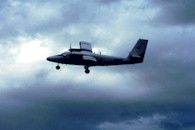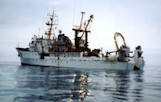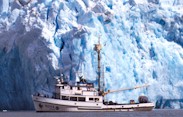
How do scientists count marine mammals?
The determination of the size of a population is very important. Some methods of counting (censusing) marine mammals include:
1) Ground counts. The observer counts the animals from the edge of a colony or by actually walking in the colony counting animals. This is useful for counting pinniped colonies.
2) Shore-based counts. Marine mammals are counted in the water while the observer is located on shore. This is useful for cetacean counts where cetaceans are consistently found in the same locations at the same time of year. (For example, during gray whale or bowhead whale migrations, humpback feeding, or at calving locations).
3) Aerial surveys. The observer counts animals from aircraft flying overhead aircraft. This is useful for both cetacean and pinniped counts in which a large area needs to be surveyed over a relatively short time. It also useful when pinnipeds are easily disturbed by observers on the ground, or are in an area inaccessible by boat or on foot. Aerial surveys are often used to photograph and to count large numbers of animals (for example dolphins in large schools, harbor seals hauled out on sand bars). Photographs are also taken of individuals, to identify individuals from unique markings and to measure length of animals to determine sex and approximate age.
An aircraft used for a cetacean aerial survey and an aerial survey photograph.
4) Ship-based surveys. The observer counts animals from a ship (useful for estimating abundance of marine mammals over large distances, and in areas that are difficult to access by airplane, for example open ocean areas, pack ice in polar areas. Often, ship-based surveys are combined with aerial surveys (using helicopters deployed from ships) to increases the area that can be covered.
NOAA's Miller Freeman and John N. Cobb are used for various marine studies.
What happens when all animals cannot be easily counted?
A smaller group is counted and the total population is estimated from this number. For example, scientists may divide a rookery into 4 geographical sections, count the population of one section, and conclude by multiplying the count by 4. To illustrate this example, there may be 103 animals between the water and a big rock and a tide pool (that form 1/4 of the rookery area). Scientists would then estimate that there are 412 animals at this one rookery. Scientific population estimates can be very useful for further scientific inquiry.
What are the main differences between censusing pinnipeds and cetaceans?
Pinnipeds are usually counted when they are on land while cetaceans are always counted in water.
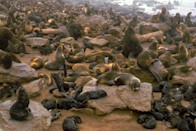
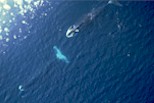
Images from a Northern fur seal rookery count and a bowhead whale aerial count.
What are the difficulties in counting pinnipeds?
Because pinnipeds are usually counted on land, one difficulty with these counts is that large colonies have animals constantly coming and going. It becomes very difficult to account for all animals. One way that scientists address this problem is by tagging a small number of individuals and determining the fraction of time they spend ashore. Researchers estimate the total population from a count of animals on the shore (referred to as "hauled out"), and then correct the estimation for animals that are missed during the count because they were in the water. Often, pups are counted as an index of size of the colony, since when pups are small, they do not move in and out of the colony as the other animals do.
What are the advantages in counting pinnipeds?
Pinnipeds are usually easy to find because many breed repeatedly in the same locations; these are known as rookeries. Pinnipeds are counted on land because it is much easier and less expensive than trying to count animals in the water.
What are the difficulties in counting cetaceans?
Cetaceans can be harder to find and count than pinnipeds, because all of the species reside in the water. It is much harder to account for animals under water. Cetaceans are also difficult to count because not all of the species gather in predictable breeding areas. Some species of cetaceans are known only from stranded individuals, and very little is known about their distribution and abundance.
What are the advantages in counting cetaceans?
Some species of cetaceans migrate annually in predictable patterns (for example gray whales, bowhead whales), making them relatively easy to count as they pass vantage points from which they can be seen.
This portion of the NMML website is intended for a student audience and their educators.
Information within the education website should not be cited in scientific journals or publications.


